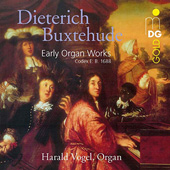

Præludium ex e (BuxWV 152)* - Pilsum
Sonata ex d - Viola da Gamba / organ (BuxWV Anh. 5)* - Norden
Præambulum ex a (BuxWV 158)* - Roskilde
Fuga ex G (BuxWV 175)* - Helsingør
Fuga ex B (BuxWV 176) - Torrlösa
Præludium ex C (BuxWV 138) - Lübeck
Nun lob, mein Seel, den Herren (BuxWV 212) - Lübeck
Ach Herr, mich armen Sünder (BuxWV 178) - Lübeck
Præludium ex e (BuxWV 142)* - Lübeck
Præludium ex F (BuxWV 144)* - Damp
Canzon ex C (BuxWV 166)* - Hamburg
Præludium ex g (BuxWV 148)* - Hamburg
Præludium ex C (BuxWV 136)* - Norden
Toccata ex d (BuxWV 155)* - Norden
* = from Codex E. B. 1688
This is not a new release per se, but rather a special collection of recordings that span from 1986 to 2018, most of which are found in Harald Vogel's
previously released 7-Disc set of Buxtehude's Complete Organ Works. With that said, the booklet notes mention that both
BuxWV 136 and BuxWV 155 were recently newly recorded based on more authentic source texts. And as a bonus, the Sonata in D for Viola da Gamba and Organ
which features Thomas Fritzsch on the viol, is a world première recording. Something all Buxtehude collectors should note.
But first and foremost I would have to say that the main appeal of this CD is the fact that it groups together on one disc, most of the organs Dieterich Buxtehude (1637-1707) played and composed on. From the smallish instrument in Pilsum to the larger ones in Lübeck and Norden, you can appreciate their varied tone colors and/or wide gamut of stop combinations each one brings to the music. One aspect that I immediately noticed is Harald Vogel's deliberately 'free' rhythmic momentum. He avoids the common pitfall, when playing contrapuntal baroque organ music, of following the notation in a rigid, immutable manner. There's an elasticity to his playing, along with his adroit and varied choice of registrations from instrument to instrument, that wards off ear fatigue. And of course the organs themselves are some of the finest examples of organ building at the time (the booklet contains pictures of six of them). And despite the pedalwork only going down to 16' stops, the St. Ludgeri organ in Norden offers a fine display of power in the mighty Toccata in D. So even if you own the aforementioned complete set, this recording is certainly worth having, not only for the chance to hear the Gamba Sonata, but also for the variety of instruments all in one trim and tidy package.
Dietrich Buxtehude began his activity at St. Mary's Church exactly 350 years ago, and the City of Lübeck fittingly commemorated this anniversary by awarding this year’s renowned Buxtehude Prize to Harald Vogel. {MDG}
Jean-Yves Duperron - November 2018